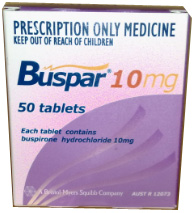Buspar Overview
Buspar is the brand name for buspirone hydrochloride, an anxiolytic drug primarily used to treat anxiety disorders and for short-term relief of symptoms of anxiety. It belongs to the class of medications known as azapirones and is unrelated to benzodiazepines or other types of anti-anxiety drugs.
Pharmacological Action
Buspirone has a high affinity for serotonin type 1A (5-HT1A) receptors and moderate affinity for brain dopamine type 2 (D2) receptors. Instead of having sedative or anticonvulsant properties, buspirone’s mechanism of action is believed to be related to its effects on serotonin and dopamine neurotransmitters, which could have modulatory influences on the synaptic transmissions that are associated with anxiety symptoms.
Indications for Use
Buspar is indicated for the management of anxiety disorders or the short-term relief of the symptoms of anxiety with or without accompanying depression. Anxiety or tension associated with the stress of everyday life usually does not require treatment with an anxiolytic.
Dosage and Administration
Buspar is typically initiated at a dose of 7.5 mg twice daily. The dose may then be increased at intervals of 2-3 days up to a maximum of 60 mg per day administered in divided doses. Doses vary depending on individual response and tolerance to medication. Effective dose adjustment should be made by a healthcare provider.
Special Dosage Considerations
In patients with hepatic or renal impairment, the initial dose and subsequent dose titrations should be made cautiously, with careful monitoring of side effects. As their metabolism and clearance may be slowed, lower doses or less frequent administration may be appropriate in such populations.
Drug Interactions
Buspar may interact with drugs that inhibit or induce cytochrome P450 3A4, as this enzyme is responsible for its metabolism. It is important to evaluate the potential for drug interactions with inhibitors like ketoconazole, itraconazole, or erythromycin and inducers like rifampin. Combining buspirone with monoamine oxidase inhibitors (MAOIs) may cause high blood pressure or hypertensive crises. Concurrent use with other central nervous system (CNS) depressants may increase sedation.
Contraindications and Precautions
Buspar is contraindicated in patients with known hypersensitivity to buspirone hydrochloride or any of the inactive components in the formulation. Caution should also be exercised when used concomitantly with MAOIs, with a recommended two-week washout period between the cessation of MAOI use and initiation of Buspar treatment.
Side Effects and Adverse Reactions
Common side effects include dizziness, headache, nausea, nervousness, lightheadedness, and excitement. In some cases, patients may experience less common effects such as blurred vision, diarrhea, dry mouth, or fatigue. A variety of other side effects have been reported; patients should be monitored for any unusual or concerning symptoms and side effect profile should be discussed with a healthcare provider.
Monitoring Parameters
While on Buspar, monitoring for response to treatment as well as for the emergence of paradoxical symptoms of anxiety or depression is recommended. For individuals with hepatic or renal impairment, ongoing monitoring of organ function might be necessary. Additionally, patients should be observed for signs of central nervous system depression if Buspar is used in conjunction with other CNS depressants.
Pregnancy and Lactation
Buspar should be used during pregnancy only if clearly needed and the benefits outweigh risks as there are no adequate and well-controlled studies in pregnant women. It’s unknown if buspirone is excreted into human milk; therefore, caution should be exercised when Buspar is administered to a nursing woman.
Pediatric and Geriatric Use
The safety and effectiveness of buspirone in pediatric patients have not been established. In geriatric patients, Buspar should be started at a low dose and increased slowly while monitoring for the occurrence of side effects, as older adults may be more sensitive to the effects of the drug.
Storage and Handling
Buspar tablets should be stored at controlled room temperature, 15° to 30°C (59° to 86°F). Dispense in a tight, light-resistant container as defined in the USP with a child-resistant closure. Keep out of reach of children.
Discontinuation of Buspar
Buspar does not produce dependence, but sudden discontinuation after prolonged use should be avoided to prevent withdrawal symptoms. Gradual dose reduction is recommended to minimize the risk of withdrawal-related effects.



Reviews
There are no reviews yet.